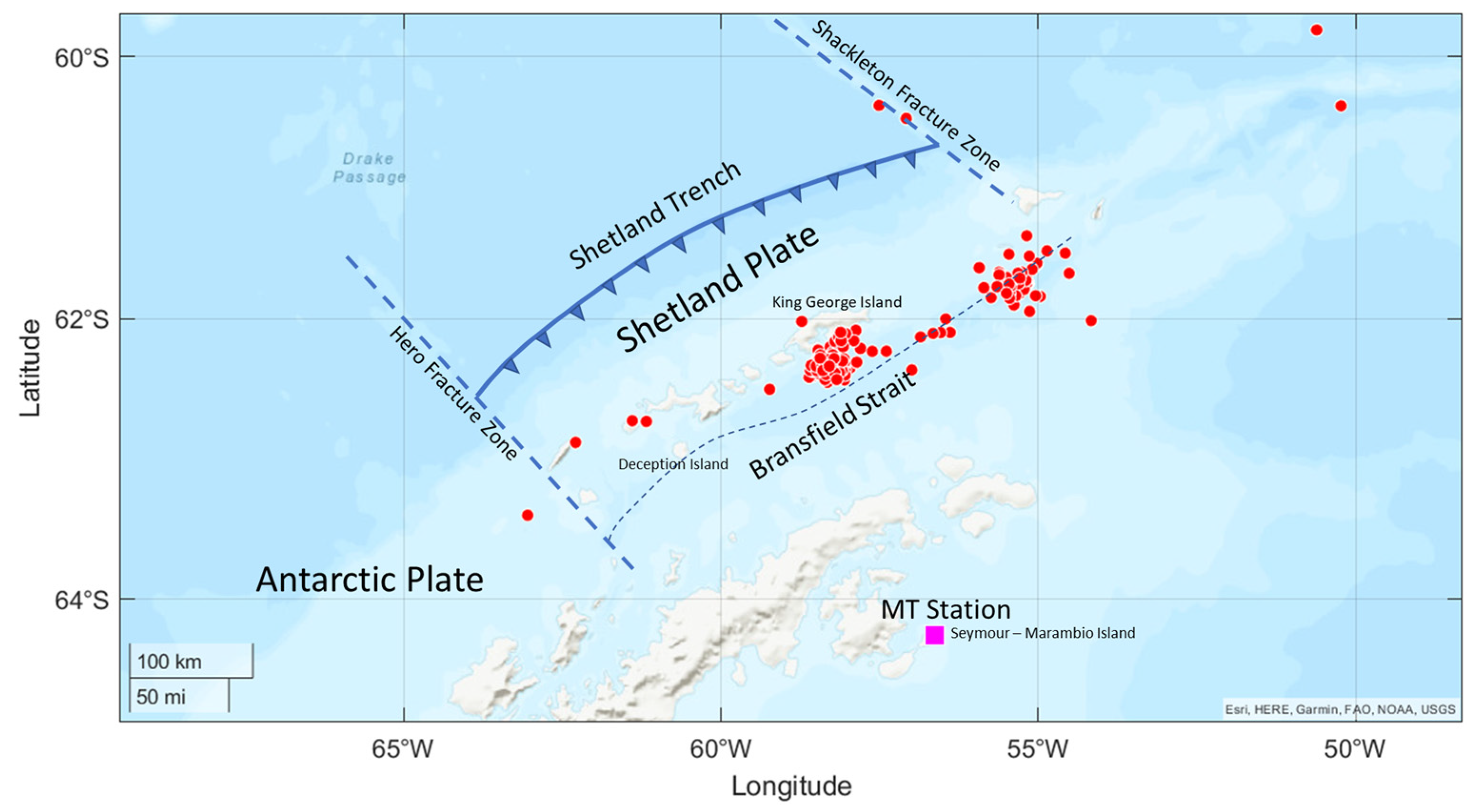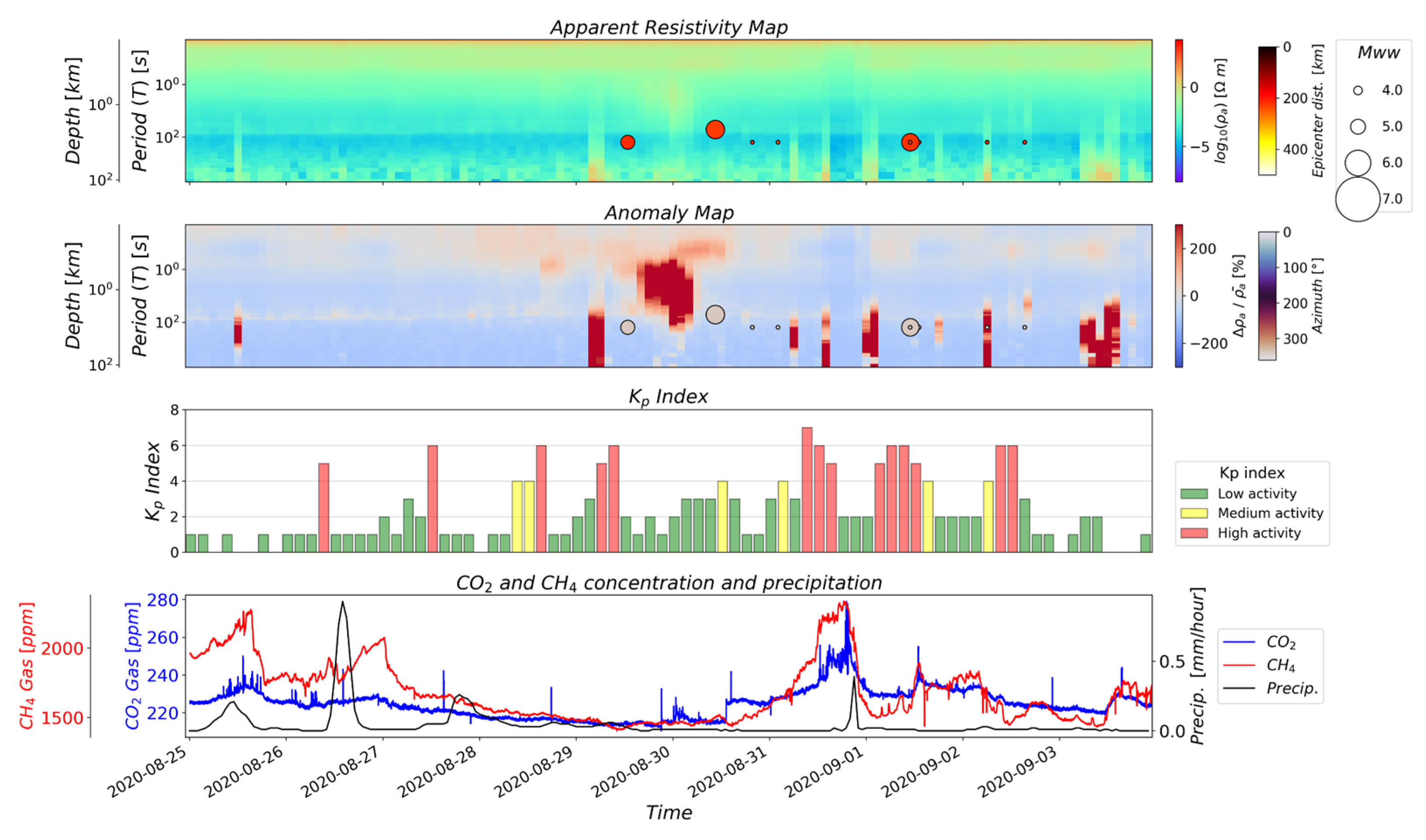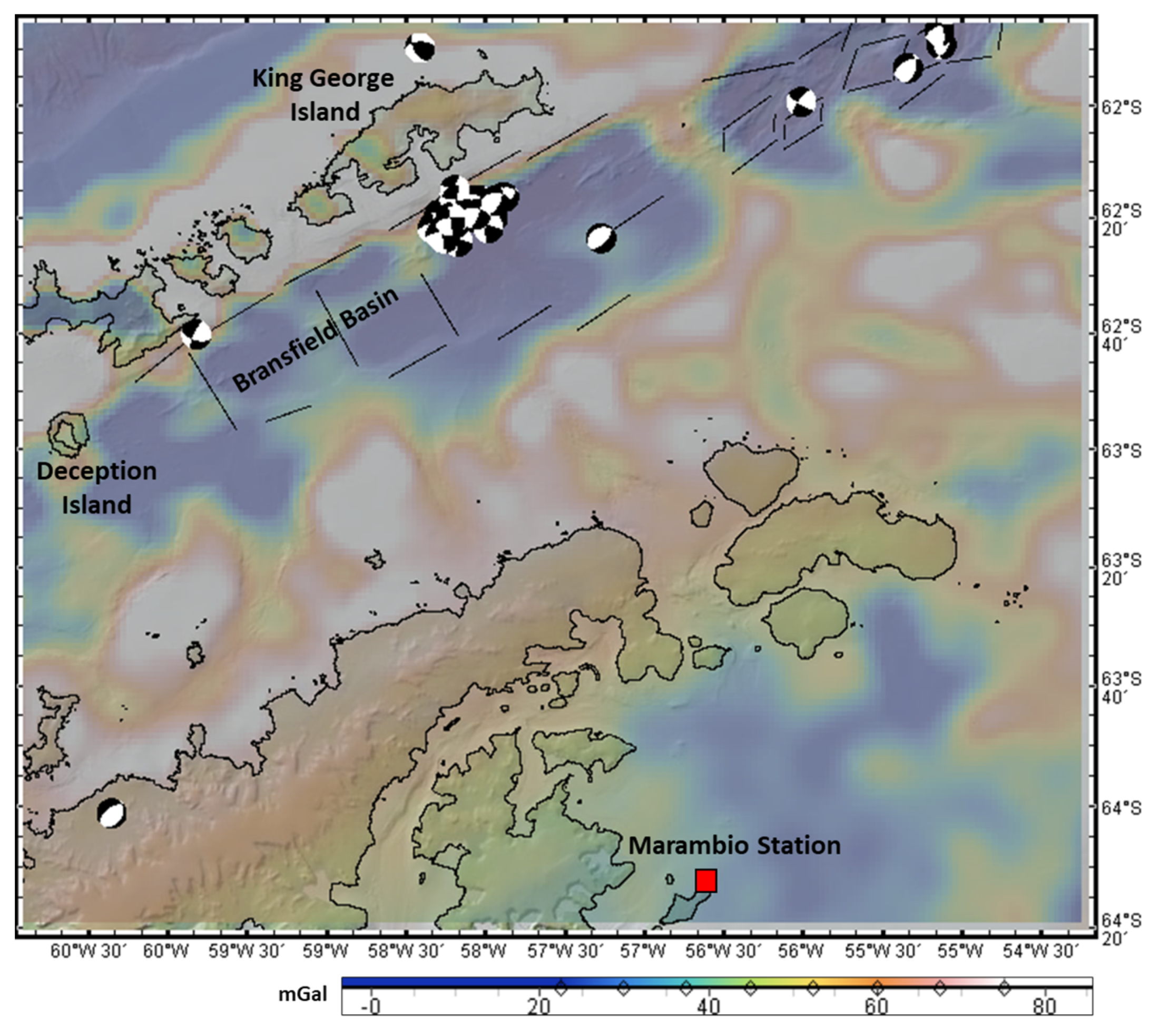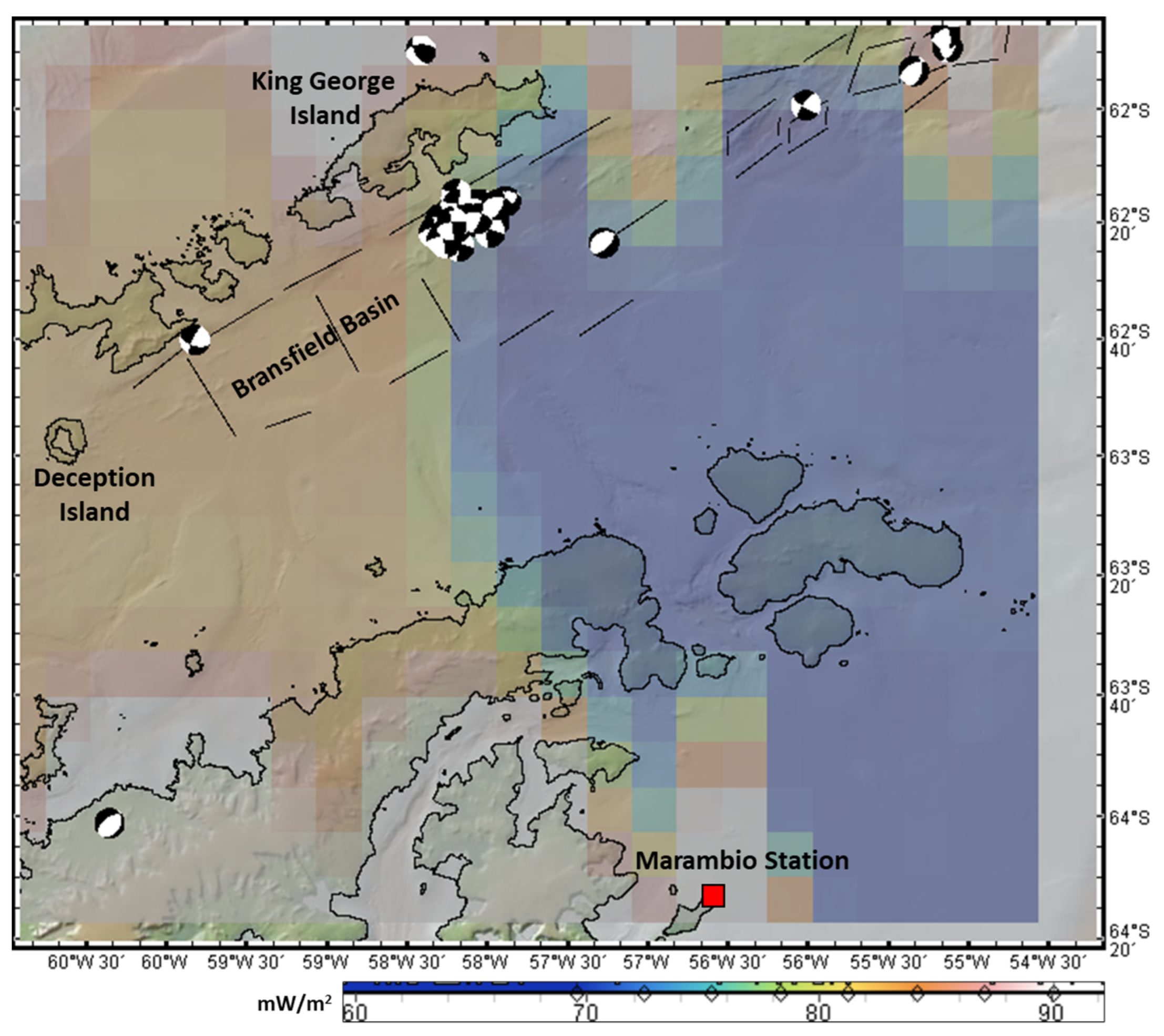Evidencing Fluid Migration of the Crust during the Seismic Swarm by Using 1D Magnetotelluric Monitoring
Abstract
1. Introduction
2. Materials and Methods
2.1. Magnetotelluric Station in the Seymour–Marambio Island
2.2. Magnetotelluric Sounding (MT)
- (1)
- Time windows of 5000 s were chosen. An overlap of 500 s was used to estimate the resistivity’s temporal evolution. Each time window was tapered with a Hanning window, and its frequency spectrum was calculated using the FFT.
- (2)
- The orthogonal components of the natural electric () and magnetic () fields were related to the impedance tensor of the subsoil in the following way [10]:where and is the magnetic permeability of free space . From the complex coefficients of the frequency spectrum, the component under the station was estimated.
- (3)
- The Schmucker–Weidelt () transfer function was estimated as follows:
- (4)
- The was calculated using the following expression:
- (5)
- The matrix was graphically represented for a given moment and different periods (depths according to Equation (1)), thus guaranteeing a space–time representation of the resistivity field that allowed detecting anomalies concerning a line base of observations.
2.3. Index
- (1)
- < 4 (weak solar activity);
- (2)
- = 4 (mean solar activity);
- (3)
- > 4 (high solar activity).
3. Results
4. Discussion
5. Conclusions
Author Contributions
Funding
Institutional Review Board Statement
Informed Consent Statement
Data Availability Statement
Acknowledgments
Conflicts of Interest
References
- Du, X.B.; Xue, S.Z.; Hao, Z.; Zhang, S.Z. On the relation of moderate–short term anomaly of earth resistivity to earthquake. Acta Seismol. Sin. 2000, 13, 393–403. [Google Scholar] [CrossRef]
- Du, X.B.; Li, N.; Ye, Q.; Ma, Z.H.; Yan, R. A possible reason for the anisotropic changes in apparent resistivity near the focal region of strong earthquake. Chin. J. Geophys. 2007, 50, 1555–1565. (In Chinese) [Google Scholar] [CrossRef]
- Fan, Y.Y.; Du, X.B.; Zlotnicki, J.; Tan, D.C.; An, Z.H.; Chen, J.Y.; Zheng, G.L.; Liu, J.; Xie, T. The electromagnetic phenomena before the Ms 8.0 Wenchuan earthquake. Chin. J. Geophys. 2010, 53, 997–1010. [Google Scholar] [CrossRef]
- Liu, J.; Du, X.B.; Zlotnicki, J.; Fan, Y.Y.; An, Z.H.; Xie, T.; Zheng, G.L.; Tan, D.C.; Chen, J.Y. The changes of the ground and ionosphere electric/magnetic fields before several great earthquakes. Chin. J. Geophys. 2011, 54, 2885–2897. [Google Scholar] [CrossRef]
- Sherif, M.A.; Ishibashi, I.; Tsuchiya, C. Pore–Pressure Prediction During Earthquake Loadings. Soils Found. 1978, 18, 19–30. [Google Scholar] [CrossRef] [PubMed]
- Chave, A.; Jones, A. The Magnetotelluric Method. In Theory and Practice, 1st ed.; Cambridge University Press: New York, NY, USA, 2012; p. 603. [Google Scholar]
- Robertson Maurice, S.D.; Wiens, D.A.; Shore, P.J.; Vera, E.; Dorman, L.M. Seismicity and tectonics of the South Shetland Islands and Bransfield Strait from a regional broadband seismograph deployment. J. Geophys. Res. 2003, 108, 2461. [Google Scholar] [CrossRef]
- Cesca, S.; Sugan, M.; Rudzinski, Ł.; Vajedian, S.; Niemz, P.; Plank, S.; Petersen, G.; Deng, Z.; Rivalta, E.; Vuan, A.; et al. Massive earthquake swarm driven by magmatic intrusion at the Bransfield Strait, Antarctica. Commun. Earth Environ. 2022, 3, 89. [Google Scholar] [CrossRef]
- Lowrie, W. Fundamentals of Geophysics, 2nd ed.; Cambridge University Press: New York, NY, USA, 2007; p. 391. [Google Scholar]
- Simpson, F.; Bahr, K. Practical Magnetotellurics; Cambridge University Press: New York, NY, USA; Cambridge, UK, 2005; 254p. [Google Scholar] [CrossRef]
- Menvielle, M.; Berthelier, A. The K–derived planetary indices: Description and availability. Rev. Geophys. 1991, 29, 415–432. [Google Scholar] [CrossRef]
- Hayes, G.P.; Rivera, L.; Kanamori, H. Source inversion of the W–Phase: Real–time implementation and extension to low magnitudes. Seismol. Res. Lett. 2009, 80, 817–822. [Google Scholar] [CrossRef]
- Vargas, C.A.; Solano, J.M.; Gulisano, A.M.; Santillana, S.; Casallas, E.A. Seismic properties of the permafrost layer using the HVSR method in Seymour–Marambio Island, Antarctica. Earth Sci. Res. J. 2022, 26, 197–204. [Google Scholar] [CrossRef]
- Haase, K.M.; Beier, C.; Fretzdorff, S.; Smellie, J.L.; Garbe–Schönberg, D. Magmatic evolution of the South Shetland Islands, Antarctica, and implications for continental crust formation. Contrib. Mineral. Petrol. 2012, 163, 1103–1119. [Google Scholar]
- Almendros, J.; Carmona, E.; Jiménez, V.; Díaz–Moreno, A.; Lorenzo, F. Volcano–tectonic activity at Deception Island volcano following a seismic swarm in the Bransfield Rift (2014–2015). Geophys. Res. Lett. 2018, 45, 4788–4798. [Google Scholar]
- Bonvalot, S.; Balmino, G.; Briais, A.; Kuhn, M.; Peyrefitte, A.; Vales, N.; Biancale, R.; Gabalda, G.; Reinquin, F.; Sarrailh, M. World Gravity Map; Commission for the Geological Map of the World: Paris, France, 2012; BGI–CGMW–CNES–IRD. [Google Scholar]
- Fuchs, A.; Norden, B. International Heat Flow Commission (2021): The Global Heat Flow Database: Release; GFZ Data Services, 2021; Available online: https://dataservices.gfz-potsdam.de/panmetaworks/showshort.php?id=5797045d-993f-11eb-9603-497c92695674 (accessed on 19 January 2023). [CrossRef]
- Gràcia, E.; Canals, M.; Farràn, M.; Sorribas, J.; Pallàs, R. The Central and Eastern Bransfield basins (Antarctica) from high–resolution swath–bathymetry data. Antarct. Sci. 1997, 9, 168–180. [Google Scholar] [CrossRef]
- Blanco, J.F.; Vargas, C.A.; Monsalve, G. Lithospheric thickness estimation beneath Northwestern South America from an S–wave Receiver Function analysis. Geochem. Geophys. Geosyst. 2017, 18, 1376–1387. [Google Scholar] [CrossRef]
- Artemieva, I.M. Lithosphere structure in Europe from thermal isostasy. Earth–Sci. Rev. 2019, 188, 454–468. [Google Scholar] [CrossRef]
- Chisenga, C.; Yan, J.; Yan, P. A crustal thickness model of Antarctica calculated in spherical approximation from satellite gravimetric data. Geophys. J. Int. 2019, 218, 388–400. [Google Scholar] [CrossRef]
- Anderson, L.A.; Johnson, G.R. Application of the self–potential method to geothermal exploration in Long Valley, California. J. Geophys. Res. 1997, 81, 1527–1532. [Google Scholar] [CrossRef]
- Warwick, J.; Stoker, C.; Meyer, T. Radio Emission Associated With Rock Fracture: Possible Application to the Great Chilean Earthquake of May 22, 1960. J. Geophys. Res. 1982, 87, 2851–2859. [Google Scholar] [CrossRef]
- Smith, B.; Johnston, M. A tectonomagnetic effect observed before a magnitude 5.2 earthquake near Hollister, California. J. Geophys. Res. 1976, 81, 3556–3560. [Google Scholar] [CrossRef]
- Zhao, Y.; Qian, F. Geoelectric precursors to strong earthquakes in China. Tectonophysics 1994, 233, 99–113. [Google Scholar]
- Wallace, R.; Teng, T. Prediction of the Sungpan–Pingwu earthquakes, 1976. Bull. Seismol. Soc. Am. 1980, 70, 1199–1223. [Google Scholar] [CrossRef]
- Gokhberg, M.; Morgounov, V.; Yoshino, T.; Tomizawa, I. Experimental Measurement of Electromagnetic Emissions Possibly Related to Earthquakes in Japan. J. Geophys. Res. 1982, 87, 7824–7828. [Google Scholar] [CrossRef]
- Gershenzon, N.; Gokhberg, M. On the origin of electrotelluric disturbances prior to an earthquake in Kalamata, Greece. Tectonophysics 1993, 224, 169–174. [Google Scholar] [CrossRef]
- Molchanov, O.A.; Kopytenko, Y.A.; Voronov, P.M.; Kopytenko, E.A.; Matiashvili, T.G.; Fraser-Smith, A.C.; Bernardi, A. Results of ULF magnetic field measurements near the epicenters of the Spitak (Ms = 6.9) and Loma–Prieta (Ms = 7.1) earthquakes: Comparative analysis. Geophys. Res. Lett. 1992, 19, 1495–1498. [Google Scholar] [CrossRef]
- Kopytenko, Y.; Matiashviali, T.; Voronov, P.; Kopytenko, E.; Molchanov, O. Detection of ultra–low–frequency emissions connected with the Spitak earthquake and its aftershock activity, based on geomagnetic pulsations data at Dusheti and Vardzia observatories. Phys. Earth Planet. Inter. 1993, 77, 85–95. [Google Scholar]
- Fraser–Smith, A.; Bernardi, A.; McGill, P.; Ladd, M.; Helliwell, R.; Villard, O. Low–frequency magnetic field measurements near the epicenter of the Ms 7.1 Loma Prieta earthquake. Geophys. Res. Lett. 1990, 17, 1465–1468. [Google Scholar] [CrossRef]
- Serebryakova, O.N.; Bilichenko, S.V.; Chmyrev, V.M.; Parrot, M.; Rauch, J.L.; Lefeuvre, F.; Pokhotelov, O.A. Electromagnetic ELF radiation from earthquake regions as observed by low altitude satellites. Geophys. Res. Lett. 1992, 19, 91–94. [Google Scholar] [CrossRef]
- Dea, J.; Hansen, P.; Boerner, W. Long–term EMF background noise measurements, the existence of window regions and applications to earthquake precursor emission studies. Phys. Earth Planet. Inter. 1993, 77, 109–125. [Google Scholar] [CrossRef]
- Shalimov, S.; Gokhberg, M. Lithosphere–ionosphere coupling mechanism and its application to the earthquake in Iran on June 20, 1990. A review of ionospheric measurements and basic assumptions. Phys. Earth Planet. Inter. 1998, 105, 211–218. [Google Scholar] [CrossRef]
- Ondoh, T. Ionospheric disturbances associated with great earthquake of Hokkaido southwest coast, Japan of July 12, 1993. Phys. Earth Planet. Inter. 1998, 105, 261–269. [Google Scholar] [CrossRef]
- Hayakawa, M.; Kawate, R.; Molchanov, O.; Yumoto, K. Results of ultra–low frequency magnetic field measurements during the Guam earthquake of 8 August 1993. Geophys. Res. Lett. 1996, 23, 241–244. [Google Scholar] [CrossRef]
- Hayakawa, M.; Ito, T. Fractal analysis of ULF geomagnetic data associated with the Guam earthquake on August 8, 1993. Geophys. Res. Lett. 1996, 26, 2797–2800. [Google Scholar] [CrossRef]
- Smirnova, N.; Hayakawa, M. Fractal characteristics of the ground observed ULF emissions in relation to geomagnetic and seismic activities. J. Atmos. Sol.–Terr. Phys. 2007, 69, 1833–1841. [Google Scholar] [CrossRef]
- Hayakawa, M.; Ida, Y.; Gotoh, K. Multifractal analysis for the ULF geomagnetic data during the Guam earthquake. Electromagnetic Compatibility and Electromagnetic Ecology. In Proceedings of the IEEE 6th Int Symposium, St. Petersburg, Russia, 21–24 June 2005; pp. 239–243. [Google Scholar]
- Fujinawa, Y.; Takahashi, K. Electromagnetic radiations associated with major earthquakes. Phys. Earth Planet. Inter. 1998, 105, 249–259. [Google Scholar] [CrossRef]
- Enomoto, Y.; Tsutsumi, A.; Fujinawa, Y.; Kasahara, M.; Hashimoto, H. Candidate precursors: Pulse–like geoelectric signals possibly related to recent seismic activity in Japan. Geophys. J. Int. 1997, 131, 485–494. [Google Scholar] [CrossRef]
- Maeda, K.; Tokimasa, N. Decametric radiation at the time of the Hyogoken Nanbu earthquake near Kobe in 1995. Geophys. Res. Lett. 1996, 23, 2433–2436. [Google Scholar] [CrossRef]
- Bernard, P.; Pinettes, P.; Hatzidimitriou, P.M.; Scordilis, E.M.; Veis, G.; Milas, P. From Precursors to prediction: A few recent cases from Greece. Geophys. J. Int. 1997, 131, 467–477. [Google Scholar] [CrossRef]
- Contoyiannis, Y.; Diakonos, F.; Kapiris, P.; Peratzakis, A.; Eftaxias, K. Intermittent dynamics of critical pre–seismic electromagnetic fluctuations. Phys. Chem. Earth 2004, 29, 397–408. [Google Scholar] [CrossRef]
- Varotsos, P.; Sarlis, N.; Eftaxias, K.; Lazaridou, M.; Bogris, N.; Makris, J.; Abdulla, A.; Kapiris, P. Prediction of the 6.6 Grevena–Kozani Earthquake of May 13, 1995. Phys. Chem. Earth 1999, 24, 115–121. [Google Scholar] [CrossRef]
- Varotsos, P.; Sarlis, N.; Skordas, E. Electric Fields that “Arrive” before the Time Derivative of the Magnetic Field prior to Major Earthquakes. Phys. Rev. Lett. 2003, 91, 148501–1/148501–4. [Google Scholar] [CrossRef]
- Varotsos, P.; Sarlis, N.; Skordas, E.; Lazaridou, M. Electric pulses some minutes before earthquake occurrences. Appl Phys Lett. 2007, 90, 064104–1/064104–3. [Google Scholar] [CrossRef]
- Hayakawa, M.; Ohta, K.; Maekawa, S.; Yamauchi, T.; Ida, Y.; Gotoh, T.; Yonaiguchi, N.; Sasaki, H.; Nakamura, T. Electromagnetic precursors to the 2004 Mid Niigata Prefecture earthquake. Phys. Chem. Earth 2006, 31, 351–364. [Google Scholar] [CrossRef]
- Yonaiguchi, N.; Ida, Y.; Hayakawa, M.; Masuda, S. Fractal analysis for VHF electromagnetic noises and the identification of preseismic signature of an earthquake. J. Atmos. Sol.–Terr. Phys. 2007, 69, 1825–1832. [Google Scholar] [CrossRef]
- Biagi, P.; Ermini, A.; Kingsley, S. Disturbances in LF Radio Signals and the Umbria–Marche (Italy) Seismic Sequence in 1997–1998. Phys. Chem. Earth 2001, 26, 755–759. [Google Scholar] [CrossRef]
- Fino, J.M.S.; Caneva, A.; Vargas, C.A.; Ochoa, L.H. Electrical and magnetic data time series’ observations as an approach to identify the seismic activity of non–anthropic origin. Earth Sci. Res. J. 2021, 25, 297–307. [Google Scholar] [CrossRef]
- Vargas, C.A.; Gómez, J.S.; Gómez, J.J.; Solano, J.M.; Caneva, A. Comment on seismic electric signals (SES) and earthquakes: A review of an updated VAN method and competing hypotheses for SES generation and earthquake triggering by Daniel S. Helman. Phys. Earth Planet. Inter. 2021, 313, 106676. [Google Scholar] [CrossRef]
- Varotsos, P.A.; Sarlis, N.V.; Skordas, E.S.; Tanaka, H.K.; Lazaridou, M.S. Entropy of Seismic Electric Signals: Analysis in the Natural Time under Time Reversal. Phys. Rev. E 2006, 73, 031114. [Google Scholar] [CrossRef]
- Varotsos, P.A.; Sarlis, N.V.; Skordas, E.S. Detrended fluctuation analysis of the magnetic and electric field variations that precede rupture. Chaos Interdiscip. J. Nonlinear Sci. 2009, 19, 02311. [Google Scholar] [CrossRef] [PubMed]
- Uyeda, S.; Nagao, T.; Kamogawa, M. Short–term earthquake prediction: Current status of seismo–electromagnetics. Tectonophysics 2009, 470, 205–213. [Google Scholar] [CrossRef]
- Cicerone, R.; Ebel, J.; Britton, J. A systematic compilation of earthquake precursors. Tectonophysics 2009, 476, 371–396. [Google Scholar] [CrossRef]
- Zhang, X.M.; Zeren, Z.M.; Shen, X.H. Analysis on variation of electric field spectrum at cut–off frequency before strong earthquakes: Taking 2006 Tonga Mw8.0 earthquake as an example. Acta Seismol. Sin. 2011, 33, 451–460. [Google Scholar]
- Sarlis, N.V.; Skordas, E.S.; Varotsos, P.A.; Nagao, T.; Kamogawa, M.; Uyeda, S. Spatiotemporal variations of seismicity before major earthquakes in the Japanese area and their relation with the epicentral locations. Proc. Natl. Acad. Sci. USA 2015, 112, 986–989. [Google Scholar] [CrossRef] [PubMed]
- Stanica, D.; Stanica, D.A. Anomalous pre–seismic behavior of the electromagnetic normalized functions related to the intermediate depth earthquakes occurred in Vrancea zone, Romania. Nat. Hazards Earth Syst. Sci. 2011, 11, 3151–3156. [Google Scholar] [CrossRef]
- Petraki, E.; Nikolopoulos, D.; Chaldeos, Y.; Coulouras, G.; Nomicos, C. Fractal evolution of MHz electromagnetic signals prior to earthquakes: Results collected in Greece during 2009. Geomat. Nat. Hazards Risk 2016, 7, 550–564. [Google Scholar] [CrossRef]
- Koulakov, I.; Vargas, C.A. Evolution of the magma conduit beneath the Galeras volcano inferred from repeated seismic tomography. Geophys. Res. Lett. 2018, 45, 7514–7522. [Google Scholar] [CrossRef]
- Ugalde, A.; Carcolé, E.; Vargas, C.A. S–wave attenuation characteristics in the Galeras volcanic complex (south western Colombia). Phys. Earth Planet. Inter. 2010, 181, 73–81. [Google Scholar] [CrossRef]
- Carcolé, E.; Ugalde, A.; Vargas, C.A. Three–dimensional spatial distribution of scatterers in Galeras volcano, Colombia. Geophys. Res. Lett. 2006, 33, L08307. [Google Scholar] [CrossRef]







Disclaimer/Publisher’s Note: The statements, opinions and data contained in all publications are solely those of the individual author(s) and contributor(s) and not of MDPI and/or the editor(s). MDPI and/or the editor(s) disclaim responsibility for any injury to people or property resulting from any ideas, methods, instructions or products referred to in the content. |
© 2023 by the authors. Licensee MDPI, Basel, Switzerland. This article is an open access article distributed under the terms and conditions of the Creative Commons Attribution (CC BY) license (https://creativecommons.org/licenses/by/4.0/).
Share and Cite
Vargas, C.A.; Caneva, A.; Solano, J.M.; Gulisano, A.M.; Villalobos, J. Evidencing Fluid Migration of the Crust during the Seismic Swarm by Using 1D Magnetotelluric Monitoring. Appl. Sci. 2023, 13, 2683. https://doi.org/10.3390/app13042683
Vargas CA, Caneva A, Solano JM, Gulisano AM, Villalobos J. Evidencing Fluid Migration of the Crust during the Seismic Swarm by Using 1D Magnetotelluric Monitoring. Applied Sciences. 2023; 13(4):2683. https://doi.org/10.3390/app13042683
Chicago/Turabian StyleVargas, Carlos A., Alexander Caneva, Juan M. Solano, Adriana M. Gulisano, and Jaime Villalobos. 2023. "Evidencing Fluid Migration of the Crust during the Seismic Swarm by Using 1D Magnetotelluric Monitoring" Applied Sciences 13, no. 4: 2683. https://doi.org/10.3390/app13042683
APA StyleVargas, C. A., Caneva, A., Solano, J. M., Gulisano, A. M., & Villalobos, J. (2023). Evidencing Fluid Migration of the Crust during the Seismic Swarm by Using 1D Magnetotelluric Monitoring. Applied Sciences, 13(4), 2683. https://doi.org/10.3390/app13042683







